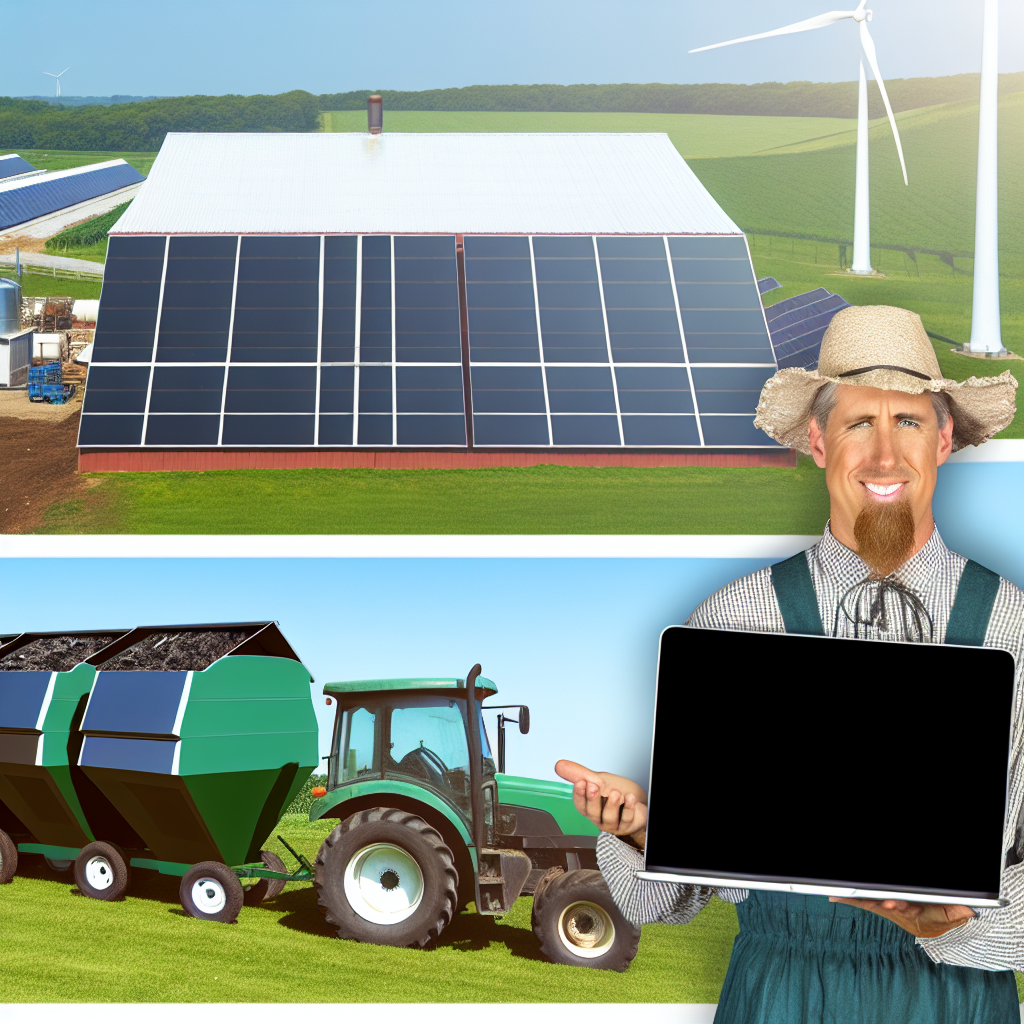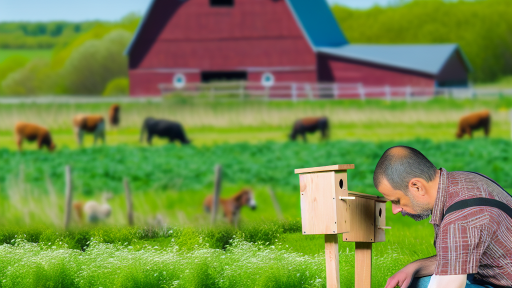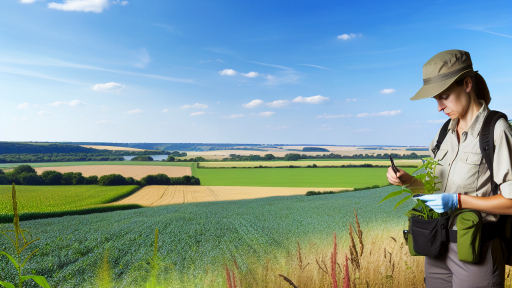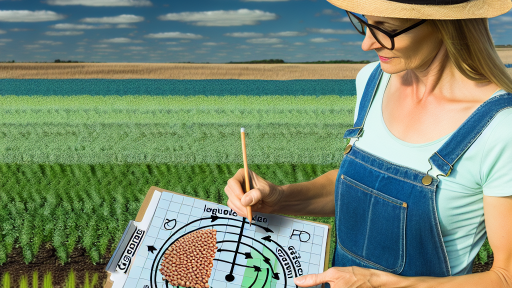Introduction to Farm Waste and its Impact on the Environment
Farm waste encompasses all organic and inorganic materials produced during agricultural activities.
Such waste includes crop residues, livestock manure, and packaging materials.
The accumulation of farm waste has significant environmental consequences.
Primarily, it contributes to soil degradation and water pollution.
Improper management leads to the release of harmful greenhouse gases.
Additionally, waste decomposition can emit methane, a potent climate change agent.
Farm waste often contaminates local water sources, harming aquatic ecosystems.
Moreover, excessive waste can disrupt biodiversity in related habitats.
Farmers face challenges in managing this waste effectively.
Traditionally, many rely on methods like burning or improper disposal.
These methods further exacerbate environmental issues.
Therefore, innovative solutions are essential for tackling farm waste.
Implementing green technologies can significantly mitigate these impacts.
Such technologies promote sustainable farming practices.
They also provide economic benefits through reduced waste disposal costs.
Transform Your Agribusiness
Unlock your farm's potential with expert advice tailored to your needs. Get actionable steps that drive real results.
Get StartedOverall, addressing farm waste is crucial for a healthier planet.
It requires collective efforts from farmers, policymakers, and communities.
Overview of Green Technologies in Agriculture
Definition and Importance
Green technologies refer to sustainable innovations in agriculture.
They aim to reduce waste and environmental impact.
Importantly, these technologies promote resource efficiency.
Farmers can enhance productivity while improving ecological health.
Types of Green Technologies
- Precision agriculture utilizes data for informed decision-making.
- Biotechnology enhances crop resilience to pests and diseases.
- Renewable energy sources reduce dependence on fossil fuels.
- Organic farming emphasizes natural inputs to improve soil health.
Examples of Successful Implementation
Farmers across the globe adopt green technologies successfully.
For instance, Sarah Thompson from Green Valley Farms uses precision irrigation.
This method significantly minimizes water waste and boosts crop yields.
Similarly, Oak Hill Organic Farms employs natural pest control methods.
As a result, they reduce pesticide use while maintaining healthy crops.
Challenges in Adopting Green Technologies
Some farmers face barriers in implementing these technologies.
High initial costs deter many from transitioning to greener practices.
Additionally, lack of knowledge about technology hinders adoption.
Furthermore, climate variability adds complexity to agricultural planning.
Future Prospects
Innovations in green technologies continue to evolve rapidly.
In the future, governments may offer incentives for adoption.
Research and development will likely lead to more efficient practices.
Ultimately, sustainable farming will play a critical role in food security.
Case Studies: Successful Implementation of Green Technologies in Farming
Green technologies have transformed farming practices globally.
These innovations reduce waste and improve sustainability.
This section examines successful case studies highlighting these advancements.
Vertical Farming in Urban Areas
Urban agriculture has embraced vertical farming techniques.
Companies like GreenSky have pioneered this method.
Showcase Your Farming Business
Publish your professional farming services profile on our blog for a one-time fee of $200 and reach a dedicated audience of farmers and agribusiness owners.
Publish Your ProfileThey utilize stacked layers to cultivate crops efficiently.
This approach minimizes land use while maximizing production.
Furthermore, it reduces transportation emissions by sourcing food locally.
Impact on Waste Reduction
Vertical farming reduces food waste significantly.
Excess produce is minimized through precise growing methods.
Additionally, they recycle water, ensuring sustainable usage.
This promotes a closed-loop system within urban agriculture.
Precision Agriculture Technologies
Precision agriculture improves resource efficiency on farms.
Farmers use GPS technology to monitor crop health accurately.
For instance, AgriTech Solutions provides drones for field analysis.
These drones deliver real-time data, allowing targeted interventions.
This reduces input waste, enhancing overall yield.
Effective Resource Management
Water and fertilizer management has significantly improved.
Farmers can apply resources precisely where needed.
Consequently, this leads to lower costs and ecological impacts.
Moreover, it encourages the adoption of organic farming practices.
Utilization of Biodegradable Materials
Farmers are increasingly adopting biodegradable materials in farming.
Companies like EcoFarms offer compostable planting pots.
These materials help reduce plastic waste in agriculture.
Additionally, they enrich the soil as they decompose.
Thus, they support a healthier ecosystem for future crops.
Positive Effects on Soil Health
Using biodegradable materials enhances soil quality.
This improves moisture retention and nutrient availability.
As a result, crops can grow more robustly and sustainably.
Ultimately, this leads to increased agricultural productivity.
Success Stories from Around the Globe
Numerous farms worldwide have benefitted from green technologies.
For example, Blue Planet Farms in California showcases efficient aqua farming.
They use innovative water filtration systems to reduce waste.
Additionally, they have improved fish farming practices significantly.
This method leads to higher yields and healthier ecosystems.
Community and Economic Benefits
These advancements have fostered community engagement in farming.
Local farmers share resources, knowledge, and technology.
This collaboration enhances overall community resilience.
Economic growth follows as sustainable practices attract investments.
Find Out More: Implement Crop Rotation for Eco-Friendly Farming
Waste Reduction Techniques: Composting and Biomass Conversion
Understanding Composting
Composting is an effective method to reduce farm waste.
It transforms organic material into nutrient-rich compost.
This process involves biodegradation by microorganisms.
Farmers can use compost to enrich soil quality.
Moreover, composting reduces methane emissions from landfills.
Showcase Your Farming Business
Publish your professional farming services profile on our blog for a one-time fee of $200 and reach a dedicated audience of farmers and agribusiness owners.
Publish Your ProfileSteps for Effective Composting
- Select a suitable composting site on the farm.
- Gather organic waste like crop residues and manure.
- Ensure proper aeration within the compost pile.
- Monitor the moisture level to maintain compost activity.
- Turn the pile regularly to facilitate decomposition.
By following these steps, farmers can optimize their composting efforts.
Benefits of Composting
Composting improves soil structure and moisture retention.
It enhances soil fertility, leading to better crop yields.
Farmers can also save money by reducing the need for chemical fertilizers.
Additionally, composting fosters a healthier ecosystem on the farm.
Exploring Biomass Conversion
Biomass conversion is another promising waste reduction technique.
This process involves converting organic material into energy.
Farmers can utilize various biomass sources for this purpose.
Common feedstocks include crop residues, livestock waste, and more.
Methods of Biomass Conversion
- Direct combustion generates heat and electricity.
- Gasification converts biomass into syngas for energy production.
- Fermentation transforms biomass into biofuels like ethanol.
These methods provide sustainable energy alternatives for farms.
Advantages of Biomass Conversion
Biomass conversion reduces dependency on fossil fuels.
It offers an effective way to manage agricultural waste.
Furthermore, it contributes to reducing greenhouse gas emissions.
Farmers can thus generate energy while minimizing waste.
Uncover the Details: Biodiversity’s Role in Soil Health
The Role of Precision Agriculture in Minimizing Waste
Understanding Precision Agriculture
Precision agriculture utilizes technology to enhance farming efficiency.
This approach focuses on optimal resource use across farmland.
Farmers can apply inputs like water, fertilizers, and pesticides more accurately.
As a result, they minimize waste and reduce environmental impact.
Technology-Driven Solutions
Advancements in GPS and satellite imagery drive precision agriculture forward.
These technologies help farmers monitor crop health effectively.
In addition, they facilitate targeted interventions based on real-time data.
Farmers can identify problem areas and address them promptly.
Data Collection and Analysis
Data collection plays a crucial role in precision agriculture.
Farmers gather information on soil conditions, weather, and crop performance.
They analyze this data to develop tailored strategies for crop management.
This analysis helps in optimizing yield while minimizing waste.
Benefits of Precision Agriculture
Utilizing precision agriculture offers numerous benefits to farmers.
- Reduces excess use of inputs like water and fertilizers.
- Minimizes environmental pollution and soil degradation.
- Enhances crop yield and profitability.
Moreover, this approach promotes sustainable farming practices.
Real-World Examples
Several farms exemplify successful precision agriculture implementations.
For instance, Green Valley Farms uses drones to monitor crop health.
This strategy allows them to deploy resources where they are needed most.
Consequently, they have significantly reduced waste and increased efficiency.
Future Prospects
The future of precision agriculture looks promising.
Emerging technologies will continue to enhance farming practices.
As a result, farmers will likely achieve even greater efficiency and sustainability.
Continued investment in research and development is essential for progress.
Gain More Insights: Soil Moisture Conservation Tips for Farmers
Utilizing Renewable Energy Sources on Farms
Introduction to Renewable Energy in Agriculture
Renewable energy transforms the landscape of modern farming.
This approach minimizes carbon footprints effectively.
Showcase Your Farming Business
Publish your professional farming services profile on our blog for a one-time fee of $200 and reach a dedicated audience of farmers and agribusiness owners.
Publish Your ProfileMoreover, it leads to significant cost savings on energy bills.
Types of Renewable Energy for Farms
Farmers have various renewable energy options available.
Solar power captures sunlight for electricity production.
Wind energy harnesses breezes to generate power.
Biomass energy uses organic materials, promoting waste reduction.
Hydropowered systems utilize water flow for energy generation.
Advantages of Solar Power
Solar panels offer numerous benefits for farmers.
They provide an abundant energy source during sunny months.
In addition, solar installations require minimal maintenance.
Tax incentives often help farmers offset installation costs.
Advantages of Wind Energy
Wind turbines can be a powerful asset on open farms.
They convert wind into electricity efficiently.
Moreover, they can potentially generate income through energy sales.
Implementing Biomass Energy
Biomass energy solutions utilize agricultural waste effectively.
This process reduces landfill waste while producing energy.
Farmers can convert manure, crop residues, and other organic matter.
Advantages of Hydropower
Hydropower systems can provide reliable energy for farms near water sources.
They promote sustainable energy use and reduce dependency on fossil fuels.
Additionally, hydropower is beneficial in regions with consistent water flow.
Challenges and Considerations
Investing in renewable energy requires careful planning.
Farmers must assess their energy needs and resources.
They should evaluate upfront costs versus long-term savings.
Furthermore, regulations and permits may vary by location.
Success Stories
Many farmers have successfully adopted renewable technologies.
For instance, Green Valley Farms utilizes solar panels to power operations.
This decision has cut their energy costs by 40%.
Additionally, Windy Acres implemented wind turbines, generating surplus energy.
These farmers inspire others to consider sustainable practices.
Delve into the Subject: Innovative Waste Management Ideas for Farmers

Advanced Irrigation Techniques to Reduce Water Waste
Precision Agriculture
Precision agriculture utilizes technology for better resource management.
This method involves collecting data on soil conditions and weather patterns.
Farmers can make informed decisions about irrigation practices.
Consequently, they apply water only where it’s needed most.
This approach significantly reduces water waste.
Drip Irrigation Systems
Drip irrigation delivers water directly to plant roots.
This system minimizes evaporation and runoff effectively.
It allows for precise control over water usage.
Farmers can adjust the flow rate based on crop needs.
As a result, they use less water compared to traditional methods.
Smart Irrigation Controllers
Smart controllers automate irrigation scheduling.
Showcase Your Farming Business
Publish your professional farming services profile on our blog for a one-time fee of $200 and reach a dedicated audience of farmers and agribusiness owners.
Publish Your ProfileThey adjust watering times based on real-time data.
For instance, these systems consider weather forecasts and soil moisture.
This flexibility ensures optimal water use while promoting healthy crops.
Farmers can benefit from reduced labor costs and water bills.
Soil Moisture Sensors
Soil moisture sensors provide critical insights into moisture levels.
Farmers can monitor their fields remotely using these devices.
This technology helps determine the right time for irrigation.
It prevents overwatering, protecting both crops and the environment.
Thus, water conservation becomes a realistic goal on the farm.
Rainwater Harvesting Systems
Rainwater harvesting captures and stores runoff for later use.
This technique provides a sustainable water source for irrigation.
Farmers can reduce dependence on municipal water supplies.
Implementing these systems can lead to considerable cost savings.
Additionally, it promotes responsible water management practices.
Benefits of Using Advanced Irrigation Techniques
Adopting advanced irrigation methods improves crop yields.
Farmers experience decreased water costs and increased efficiency.
Moreover, these methods contribute to environmental sustainability.
By reducing overall water usage, farms help conserve vital resources.
This enhanced approach fosters a more resilient agricultural industry.
Innovative Approaches: Vertical Farming and Hydroponics
Understanding Vertical Farming
Vertical farming revolutionizes traditional agriculture methods.
This method maximizes space by growing crops in stacked layers.
It often utilizes controlled-environment agriculture techniques.
Farmers can optimize factors like light, temperature, and nutrients.
As a result, vertical farming reduces land usage significantly.
Moreover, it minimizes water consumption compared to conventional farming.
Many urban areas benefit from this innovative approach.
For instance, cities can produce food locally, reducing transport emissions.
Exploring Hydroponics
Hydroponics is an efficient soil-less growing technique.
This system provides plants with essential nutrients directly in water.
Hydroponics lets farmers grow crops faster than in soil.
It also allows for year-round cultivation regardless of climate.
One notable advantage is reduced pest problems.
Thus, fewer pesticides are needed, improving food safety.
Additionally, hydroponics can be implemented in urban environments.
This approach helps meet the rising demand for fresh produce.
Benefits of Integrating These Technologies
Integrating vertical farming and hydroponics leads to several benefits.
Firstly, they drastically reduce agricultural waste.
Crops grown in controlled environments often require fewer resources.
This efficiency translates to lower overall production costs.
Secondly, food quality improves due to better nutrient management.
Showcase Your Farming Business
Publish your professional farming services profile on our blog for a one-time fee of $200 and reach a dedicated audience of farmers and agribusiness owners.
Publish Your ProfileLasty, these methods enhance food security in urban centers.
Many cities are investing in these technologies to combat food deserts.
Adopting these innovations supports sustainable agriculture.
Barriers to Adopting Green Technologies in Agriculture
Financial Challenges
Many farmers face significant financial barriers when adopting green technologies.
Initial costs for sustainable equipment can be quite high.
Additionally, banks may hesitate to lend money for such investments.
Without financial support, many farmers struggle to proceed.
Long-term savings might not be immediately apparent, discouraging adoption.
Lack of Knowledge and Training
A gap in knowledge hinders the transition to green technologies.
Many farmers are unaware of the benefits these technologies provide.
Training opportunities remain limited in rural areas.
Thus, farmers often feel ill-equipped to implement these changes.
Education programs can help bridge this gap.
Cultural Resistance
Cultural norms also pose significant challenges.
Tradition often dictates farming practices, making change difficult.
Farmers may resist innovations, preferring familiar methods.
Social pressures can inhibit experimentation with new technologies.
Overcoming resistance requires community engagement and support.
Regulatory Hurdles
Regulatory barriers can complicate the adoption process.
Complex permits and approvals can deter farmers from innovating.
Specification variances may create confusion and compliance challenges.
Streamlining regulations may facilitate smoother transitions to green technologies.
Collaboration between stakeholders can drive regulatory reform.
Access to Resources
Access to adequate resources is essential for adopting green technologies.
However, farmers in remote areas often lack access to necessary materials.
This includes everything from organic fertilizers to advanced equipment.
Additionally, internet access may be limited, restricting information flow.
Enhancing resource availability can encourage a broader adoption.
Future Trends: The Role of AI and IoT in Waste Management
Integrating AI into Waste Management
Artificial Intelligence is transforming waste management in agriculture.
It analyzes massive amounts of data rapidly and accurately.
For instance, AI can predict crop yields and assess waste production levels.
This capability helps farmers make informed decisions about resource allocation.
Moreover, AI-driven systems can identify inefficiencies in farming practices.
As a result, farmers can minimize waste and optimize productivity.
Leveraging IoT for Real-Time Monitoring
The Internet of Things (IoT) plays a key role in waste management.
IoT devices collect real-time data from farms.
These devices can monitor soil conditions, crop health, and waste levels.
As a consequence, farmers can respond quickly to potential issues.
IoT solutions provide actionable insights for better decision-making.
They enable farmers to implement timely interventions in their operations.
Showcase Your Farming Business
Publish your professional farming services profile on our blog for a one-time fee of $200 and reach a dedicated audience of farmers and agribusiness owners.
Publish Your ProfileEnhancing Efficiency with Smart Technologies
Smart technologies are changing how farmers manage waste.
Automated systems can efficiently sort and process waste materials.
Such systems reduce the amount of waste sent to landfills.
They also convert organic waste into valuable resources, like compost.
This conversion process enhances sustainability within agricultural practices.
Future Innovations on the Horizon
Innovations in AI and IoT continue to emerge in waste management.
For instance, machine learning algorithms improve predictive analytics.
Moreover, connectivity advances lead to more integrated farming solutions.
These developments will facilitate real-time responses to agricultural waste.
Farmers will increasingly rely on customized technology solutions.
Ultimately, these innovations will drive further reductions in waste generation.
Additional Resources
Reducing Food Waste: How & Why to Prevent Food Loss | Eden Green




